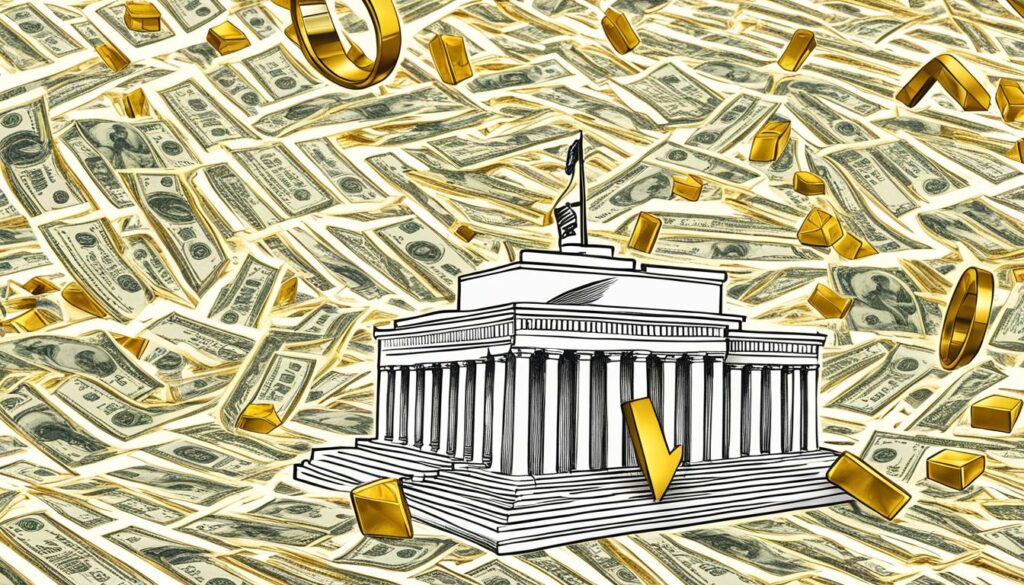Have you ever wondered why gold, a symbol of wealth and security, was once illegal to own in the United States?
The ban on gold is a key part of America’s economic history. The Gold Reserve Act of 1934 was a big change in money policy.
This law made all gold and gold certificates held by the Federal Reserve go to the U.S. Treasury. It also stopped people from owning gold privately. The goal was to help the economy during the Great Depression by controlling money and stopping hoarding.
But, the gold ownership restriction faced many legal and cultural issues until it was lifted in the 1970s. Then, Americans could own and trade gold again. This ended decades of strict monetary gold policy.
Let’s look at why this rule was made and how it affected the economy and policy for a long time.
Key Takeaways about Ban on Gold
- The historical gold ban was introduced through the Gold Reserve Act of 1934.
- It mandated the surrender of all gold and gold certificates to the U.S. Treasury.
- The ban aimed to stabilize the economy during the Great Depression by controlling the money supply.
- Private gold ownership was restricted to prevent economic hoarding.
- Challenges to the gold ownership restriction persisted until its repeal in the 1970s.
- Americans regained the right to own and trade gold freely following the repeal.
- The gold prohibition had significant long-term economic impacts on U.S. monetary policy.
Introduction to Gold as a Monetary Standard
The gold standard history is filled with importance. It shows how long gold has been linked to money. For ages, the world’s economies have used gold as a key to financial stability.
Gold was at the heart of many countries’ money systems. This made sure that money was solid and reliable. It helped build trust in how countries managed their money.
Gold certificates were key in buying and selling things. They were like tickets to gold, making trade easy and safe. This trust in gold helped connect local markets with the world.
Using gold-backed money had big benefits. It kept governments from printing too much money, which can cause inflation. It also made international trade smoother by keeping gold prices stable.
To illustrate the impact of the gold standard, consider the following comparative analysis:
| Aspect | Gold Standard Era | Post-Gold Standard Era |
|---|---|---|
| Monetary Stability | High, due to the fixed ratio of currency to gold | Varied, subject to government policies |
| Inflation Control | Effective, limited money supply expansion | Challenging, dependent on fiscal policy |
| International Trade | Stable, with predictable exchange rates | Fluctuating, influenced by market forces |
| Monetary Gold Stock | Essential for currency issuance | Less critical, replaced by fiat currency |
| Use of Gold Certificates | Common, representing physical gold | Obsolete, replaced by modern banking instruments |
The move from the gold standard to today’s money systems shows a big change in how we think about keeping the economy stable.
The old days of gold certificates and a currency backed by gold are gone. But, the ideas behind them still shape our money policies and how countries trade with each other.
Buy Gold Online: The Smart and Secure Way
Discover the safest and most reliable strategies to buy gold online. Make informed investment decisions and secure your financial future today!
Learn MoreThe Gold Reserve Act of 1934
The passage of the 1934 gold policy represented a significant shift in the U.S. monetary system. The U.S. Congress enacted the law, which President Franklin D. Roosevelt signed, with the primary aim of rejuvenating the ailing economy during the Great Depression.
Background and Passage
The Gold Reserve Act was a key move by FDR and gold reserves. It aimed to gather all gold under one roof. By moving the Federal Reserve’s gold to the U.S. Treasury, Roosevelt took control of the nation’s gold. Congress gave him the power to set the gold dollar’s value, hoping to fight off deflation and boost the economy.
Immediate Impacts on the U.S. Economy
The Gold Reserve Act was a big change for the U.S. monetary system. It aimed to make the U.S. dollar worth less, which could help raise prices and ease debt. The act also set up the Exchange Stabilization Fund to control the dollar’s value without the Federal Reserve’s help. These moves were key to getting the economy back on track during a tough time.
Executive Order 6102: The Ban on Private Gold Ownership
Executive Order 6102 was a big step by President Franklin D. Roosevelt in 1933. It made owning gold illegal, except in a few cases, to fight the Great Depression. People had to give up their gold for paper money, showing a big shift in who controlled money.
Legal Framework and Implementation
Executive Order 6102 made owning gold a crime, with some exceptions. Items like jewelry and collectible coins were okay to keep. This rule was meant to help the economy by keeping gold in the government’s hands, leading to a new value for gold.
Public Reaction and Compliance
People reacted differently to the order, with many giving up their gold to avoid trouble. But some resisted, leading to legal battles. These cases even went to the Supreme Court, which supported the order, making it law.
Exceptions and Legal Challenges
Despite the broad sweep of Executive Order 6102, there were specific exceptions to accommodate practical necessities.
For example, dentists were permitted to retain up to 100 ounces of gold for professional use. These exceptions reflected an understanding of the unique roles gold played in various fields, allowing flexibility within the stringent legal framework to address real-world needs and concerns.
| Aspect | Description |
|---|---|
| Legal Mandate | Criminalization of gold possession with mandated surrender of gold assets to comply with federal regulations. |
| Public Reaction | Mixed reactions, ranging from compliance to resistance and legal challenges. |
| Exceptions | Special allowances for certain professions and items, such as dentists owning up to 100 ounces of gold. |
| Legal Reprisals | Upheld by the Supreme Court despite resistance, securing its place in legal history. |
Economic Context of the Early 1930s
The early 1930s marked a tumultuous period in American history, defined by severe economic distress following the infamous stock market crash of 1929. The Great Depression economy was characterized by widespread financial turmoil, as banks failed, unemployment soared, and social tensions heightened.
The 1930s financial crisis led to a dire deflationary spiral, where falling prices exacerbated economic challenges. Individuals and businesses alike faced dwindling resources, pushing many to insolvency. This was a time when the stock market crash aftermath left a profound impact on everyday life, shaping the policy responses of the federal government.
As deflation took hold, the federal government enacted drastic measures to halt the economic decline. Among these, the ban on gold ownership stood out as a significant policy that aimed to stabilize and spur economic recovery. In undertaking such measures, the administration hoped to reverse the deflationary spiral and restore confidence within the Great Depression economy.
Effects of the Gold Ban on Inflation and Deflation
The prohibition on gold brought notable changes to the U.S. economy, particularly impacting inflation and deflation rates. Initially, the short-term economic outcomes were quite pronounced.
Short-term Economic Outcomes
One of the immediate effects of the gold prohibition was the gradual alleviation of the deflationary spiral that plagued the economy.
With the Gold Reserve Act of 1934 in place, the U.S. saw an end to extreme deflation, such as the staggering negative ten and a half percent recorded in 1921. Post-1934, inflation rates became more stable, albeit higher, ensuring that deflation never plunged below negative 2.1 percent. This shift marked a significant change in the economic policy outcomes during that period.
Long-Term Financial Implications
Over the long term, the gold prohibition had profound financial implications. Between 1930 and 1940, gold reserves in the U.S. tripled. This substantial increase in reserves also transformed the landscape of monetary policy.
The end of deflation enabled more consistent inflation rates, offering a more predictable economic environment. Consequently, these gold prohibition consequences shaped how economic policies would be crafted and implemented for decades to come.
The Repeal of the Gold Ban in the 1970s
The 1970s were a transformative period for gold ownership in the United States, marked by significant legislative changes and presidential actions. These efforts led to the eventual gold ownership restoration under President Gerald Ford.

Legislative Changes and Presidential Actions
The Presidential influence on gold policy was crucial in repealing the ban on gold ownership. President Gerald Ford, swayed by pro-gold arguments, utilized his executive powers to restore the rights of Americans to own and trade gold. This monumental shift was solidified through legislative changes that reflected a growing consensus on the need to amend restrictive gold policies.
Economic Conditions Leading to the Repeal
The repeal in the 1970s was driven by various 1970s economic policy concerns and pressures. Key among these was the realization that foreign governments exchanging dollars for gold were draining U.S. reserves and exacerbating the federal deficit. This untenable situation prompted a reevaluation of existing policies, culminating in the restoration of gold ownership rights.
Below is a detailed overview of critical legislative and presidential actions during this period:
| Year | Action | President |
|---|---|---|
| 1971 | Nixon ends gold convertibility, leading to the Nixon Shock | Richard Nixon |
| 1974 | Legislation passed to legalize private gold ownership | Gerald Ford |
| 1975 | Gold ownership officially restored | Gerald Ford |
Modern Implications: Could a Ban on Gold Happen Today?
As we navigate the complexities of the modern gold trade, discussions around the potential for a gold ban arise occasionally. Reflecting on historical events, it is intriguing to ponder whether today’s economic landscape could sustain such a drastic measure.
Presently, the current economic safeguards make a gold ban seem improbable. These safeguards include diversified financial instruments, global interconnectedness, and increased transparency in policymaking. Unlike the isolated financial systems of the past, today’s economy is intricately connected on a global scale, adding layers of complexity to any potential ban.
Advancements in financial technology and vibrant international markets further complicate the feasibility of such a ban. The evolution of investor preferences, leaning towards digital assets and other commodities, indicates a significant shift from the gold-centric focus of earlier times. This shift underscores the adaptability of modern economics, making the talk of a gold ban somewhat theoretical rather than practical.
Additionally, various current economic safeguards provide stability and flexibility that were not available in the past. Transparent policymaking mechanisms and robust financial regulations ensure a resilient economic framework, capable of withstanding pressures without resorting to outdated measures like a gold ban.
Altogether, while it is an engaging debate, the likelihood of a contemporary gold ban seems minimal given the robust nature of the modern gold trade and well-established current economic safeguards.
Comparison with Cryptocurrency Regulations
When we look at the history of financial assets, there are notable comparisons to draw between the regulation of gold and the emerging discussions around Bitcoin and cryptocurrencies. This comparison reveals several interesting aspects of government interventions and financial policies.

What Lessons Can We Learn from the Gold Ban?
The prohibition on gold taught us significant lessons about the balance between monetary control and individual financial freedom. The 1930s gold ban allowed the U.S. government to control the money supply and stabilize the economy during the Great Depression. Today, one might wonder whether similar tactics could be applied to cryptocurrencies. The lessons from the gold ban can illuminate the strategies governments might use to regulate Bitcoin and other digital currencies. These lessons highlight the tension between governmental regulation and the growing market for decentralized financial assets.
Gold has traditionally been a controlled asset, especially in times of economic uncertainty. Comparatively, cryptocurrencies like Bitcoin are digital and decentralized, making government regulation more complex and controversial. It’s crucial to consider how historical actions, like the gold ban, inform current discussions about Bitcoin regulation and the possibilities of a cryptocurrency ban.
Could Governments Ban Bitcoin?
The question of a cryptocurrency ban is pertinent in current debates. If we consider the precedent set by the gold ban, it’s not entirely out of the realm of possibility for governments to attempt to restrict Bitcoin. However, the decentralized nature of cryptocurrencies presents unique challenges that differ from the gold ban’s implementation. Governments might find it more difficult to enforce a ban on an asset that isn’t physically held and is spread across numerous digital wallets worldwide.
Legal frameworks are evolving to address these new challenges, but the potential for a cryptocurrency ban will continually spark debate. Crypto proponents argue that such an effort would stifle innovation and individual financial freedom, while others see potential benefits in protecting national financial systems from unregulated financial instruments. Thus, the comparison between crypto versus gold remains a crucial focal point in understanding the future landscape of financial regulation.
In light of these considerations, the discussion of regulating Bitcoin and other cryptocurrencies remains dynamic and encompasses broader themes of economic policy, technological innovation, and individual liberties. Comparing these regulatory possibilities with historical gold regulations provides valuable insights into the future of these digital assets.
Global Impacts of Gold Regulations
Gold regulations in the United States have had significant repercussions worldwide. The alterations in U.S. policy led to considerable shifts in how other nations managed their own gold reserves. This ripple effect underscored the pivotal role the U.S. plays in the global gold reserve dynamics and highlighted the varied international response to U.S. gold policy.
International Shifts in Gold Reserves
In the wake of stringent U.S. gold regulations, numerous countries re-evaluated their gold reserve strategies. A notable escalation in U.S. gold reserves ensued, while nations like Britain and France faced different challenges. Britain’s suspension of the gold standard in 1931 marked a pivotal point, leading to further restructuring in global gold reserves. This period saw countries adjusting their policies in response to the new American monetary landscape.
Comparative Analysis with Other Nations
| Country | Gold Reserves Adjustment | Policy Response |
|---|---|---|
| United States | Increased reserves | Implemented Gold Reserve Act of 1934 |
| Britain | Fluctuating reserves | Suspended gold standard in 1931 |
| France | Stabilized reserves | Maintained conservative gold policies |
This comparative analysis showcases how different nations navigated the complexities of gold regulations during a transformative period. By examining the international response to U.S. gold policy, we can better understand the intricate global gold reserve dynamics and the broader comparison of national gold regulations.
The Role of the Federal Reserve and the Treasury
The Federal Reserve monetary policy and Treasury’s gold policy underwent significant transformations with the implementation of the Gold Reserve Act. This Act facilitated the establishment of the Exchange Stabilization Fund (ESF), which was a monumental step in the United States fiscal authority landscape. The ESF endowed the Treasury with greater control over gold and monetary policies, thereby altering the dynamics between the Federal Reserve and the Treasury.

| Entity | Pre-1935 Role | Post-1935 Role |
|---|---|---|
| Federal Reserve | Independent Monetary Policies | Implementing Treasury’s Policies |
| Treasury | Limited Control Over Monetary Policy | Expanded Control Through ESF |
The Central Banking Act of 1935 further solidified this shift, ensuring that the Treasury held a dominant role in defining and executing the United States fiscal authority. This change persisted until the Fed-Treasury Accord of 1951, marking a defining era in the evolution of federal monetary management. Understanding these historical dynamics offers a nuanced perspective on the current and future interplay between these two entities.
Economic Stabilization and Use of Gold Reserves
The establishment of the Exchange Stabilization Fund (ESF) was a crucial step in the United States’ economic stabilization strategies during the 1930s.
The Establishment of the Exchange Stabilization Fund
President Franklin D. Roosevelt’s gold policy led to the creation of the ESF, funded through $2 billion from revalued gold profits. This fund provided the U.S. Treasury with significant flexibility to stabilize the dollar’s value and manage foreign exchange independently from the Federal Reserve. The Exchange Stabilization Fund was thus instrumental in executing economic stabilization strategies during this era.
Gold Sterilization Policies in the 1930s
The 1930s also saw the implementation of gold sterilization policies. Initiated by both the Federal Reserve and Treasury, these policies aimed to control monetary expansion and prevent inflation. Through these measures, the government could retain high gold reserves, ensuring that the Exchange Stabilization Fund effectively supported Roosevelt’s gold policy for economic stability.
Ban on Gold: Historical Cases and Current Opinions
The historical gold restriction review shows significant fluctuations in public sentiment towards gold bans. Different eras have exhibited varying levels of endorsement or contention regarding this policy. Observing the gold ban public opinion from the 1930s to the 1970s reveals an understandable spectrum of economic and social responses.
During the Great Depression, the gold ban was perceived as a dire necessity. Many economic strategy critiques supported the ban for its potential to stabilize the economy. However, others questioned the efficacy and ethical implications of restricting individual ownership rights.

Fast forward to recent years, public opinion on gold bans is more diversified. Economic historians often provide a historical gold restriction review analyzing the complex impacts and lessons learned. Financial experts and policymakers weigh in through the lens of current economic priorities, reflecting a nuanced perspective on such restrictions.
To better comprehend these varying perspectives, let’s look at some critical elements:
- Support during economic crises
- Legal and cultural challenges
- Modern policy implications and public attitudes
The following table summarizes key points from historical cases and today’s opinions, highlighting how perspectives on gold bans have evolved.
| Era | Public Opinion | Economic Strategy Critique |
|---|---|---|
| 1930s | Predominantly supportive due to economic necessity | Stabilizing effect on economy, debated ethical implications |
| 1970s | Mixed feelings, leading to eventual repeal | Criticism over loss of individual rights, shifting economic needs |
| Today | Diverse, with some supporting regulation while others favor freedom | Focus on balancing control with market freedoms and modern economic stability |
This historical gold restriction review and analysis of gold ban public opinion underscore the critical debate on restricting gold ownership. While the original gold bans were rooted in specific economic contexts, modern discussions consider broader implications and evolving priorities. The ongoing economic strategy critique will undoubtedly continue to shape public opinion and policy direction concerning gold ownership within the United States.
Conclusion
The history of the gold ban remains a landmark topic within the realms of U.S. economic policy, reflecting the complexities of fiscal regulation and monetary control. From the initial implementation during the throes of the Great Depression to its repeal in the 1970s, the prohibition on gold ownership exhibited the dynamic interplay between government intervention and market forces. This historical journey underscores essential economic lessons learned, particularly in terms of currency valuation and the intricate balance of government regulation versus market freedom.
Reflecting on the historical context, the evolution of gold regulations presents valuable insights for future economic strategies. The gold ban demonstrated that drastic measures could be taken to stabilize an economy in crisis, yet also highlighted the limitations of such approaches in the long run. Today, the possibility of future gold regulations must consider modern financial ecosystems, which are markedly different due to globalization, advanced technologies, and diverse financial instruments.
Ultimately, the legacy of the gold ban serves as a poignant reminder of the need for careful consideration in financial policymaking. The lessons gleaned from this period can guide future economic decisions, ensuring that balance is maintained between regulatory oversight and market-driven freedom. By understanding and reflecting on these lessons, we can navigate current and future fiscal challenges with greater insight and effectiveness.
FAQ about Ban on Gold in History and Today
What was the Gold Reserve Act of 1934?
The Gold Reserve Act of 1934 was a crucial piece of legislation aimed at overhauling the U.S. monetary system amidst the Great Depression. It mandated that all gold and gold certificates held by the Federal Reserve be surrendered to the Department of the Treasury and outlawed private gold ownership with certain exceptions.
How did the Great Depression lead to the ban on gold ownership?
The economic crisis of the early 1930s, characterized by massive deflation, bank failures, and rising unemployment, prompted the federal government to implement drastic measures, including the ban on gold, to stabilize and spur economic recovery.
What was Executive Order 6102?
Executive Order 6102, signed by President Franklin D. Roosevelt in 1933, criminalized the possession of gold by U.S. citizens, with certain exceptions, and required them to surrender their gold in exchange for paper currency.
What were the short-term economic outcomes of the gold ban?
The short-term outcomes included the gradual alleviation of deflation. After the Gold Reserve Act of 1934, the average inflation rate became more stable but higher, helping to counteract the extreme deflationary pressures of the early 1930s.
How did the repeal of the gold ban come about in the 1970s?
The repeal was marked by legislative changes and executive actions by President Gerald Ford, influenced by a growing demand for restored investment freedoms and economic conditions that made the gold ban untenable.
Could a ban on gold happen today?
In today’s financial ecosystem, characterized by global interdependency, diverse investment instruments, and more transparent policymaking, it is unlikely that a ban on gold similar to that of the 1930s could be successfully implemented.
What lessons can we learn from the gold ban when it comes to cryptocurrency regulations?
The primary lessons are about balancing monetary control with individual financial freedom. Many concerns regarding Bitcoin and other cryptocurrencies reflect worries that governments might seek similar controls to those once exercised over gold.
What was the role of the Exchange Stabilization Fund (ESF) established by the Gold Reserve Act?
The ESF, endowed with billion derived from the profits of revalued gold, was established to afford the U.S. Treasury significant leeway in stabilizing the dollar’s value and managing foreign exchange without the Federal Reserve’s involvement.
How did gold regulations in the U.S. affect international gold reserves?
Gold regulations in the U.S. led to a substantial increase in American gold reserves, while countries like Britain and France experienced different impacts, particularly highlighted by Britain’s suspension of the gold standard in 1931.
What were the long-term financial implications of the gold ban?
Long-term implications included a tripling of gold reserves from 1930 to 1940 and significant changes in U.S. monetary policy, such as increased federal control over the money supply and transformed relationships between the Federal Reserve and the Treasury.
How did the public react to Executive Order 6102?
Public reactions ranged from compliance to legal opposition. While some citizens surrendered their gold as mandated, others challenged the order legally. Exceptions were also made, such as for dentists who could own up to 100 ounces of gold.

